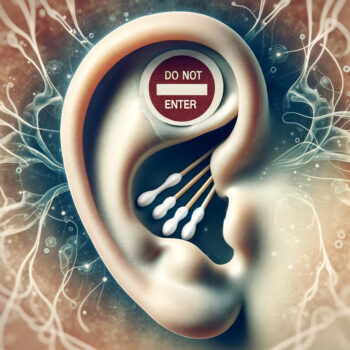Contributing writer for Wake Up World
Guidelines have recently been submitted that support something you probably already knew, that using cotton swabs to clean your ears isn’t a good idea.
The latest counsel was published in the journal Otolaryngology-Head and Neck Surgery, authored by the American Academy (AAO-HNS) advisory panel of the same name.1
You may remember the mantra that’s been repeated since you were a kid: Never put anything in your ear that’s smaller than your elbow.
[pro_ad_display_adzone id=”110028″]
But why? We all want clean ears; further, being able to hear what’s being said at the dinner table is usually a good thing, so if there’s wax buildup, getting rid of it somehow seems logical.
Dr. Seth Schwartz, chairman of the guideline update group for the Academy, said doctors aren’t the only ones paying attention to such guidelines. They’re aware that, especially in recent years, more people have been opting for self-care.
Incidentally, while one wouldn’t think such a document would be especially sought after, apparently it is. More than 50,000 copies of the old guidelines have been downloaded.
‘Nothing Smaller Than Your Elbow,’ but Why?
Two very positive things came about when the new clinical guidelines were submitted. One was that a consumer representative, not necessarily connected with the medical community, was included on the panel.
Another was that the verbiage used became much more clear and straightforward than in years past, Schwartz said, adding:
“The process has become a little more transparent in the way we actually write the guidelines now. We are more clear about why the decisions we made are made and what data there is to support it.”2
The guidelines’ answer to the “why” question is pretty concise, as CNN reported:
“Cotton swabs, hair pins, house keys and toothpicks — the many smaller-than-our-elbow-objects we love to put in our ears — can cause cuts in our ear canals, perforate our eardrums and dislocate our hearing bones.
And any of these things could lead to hearing loss, dizziness, ringing or other symptoms of ear injury.”3
The better alternative, experts say, is to let nature take its course. So how does that work for getting waxy ears clean? According to the AAO-HNSF, if your body is ridding itself of excess wax correctly, your ear canals should never have to be cleaned.4
Glands in your ears produce earwax to keep them lubricated, as well as clean and protected. The main reason it’s present is so foreign bits like dust, dirt and dead skin cells will get stuck in it rather than burrowing deeper and lodging in your ear canal.
One study lists lysozyme, an antibacterial enzyme, fatty acids, alcohols, cholesterol and squalene as natural elements in your earwax.5
Additionally, studies say earwax is produced only in the outer one-third of your ear canal, so using cotton swabs or another instrument can push earwax into the deeper part of your ear canal, near the eardrum.6
Further, using cotton swabs in your ears releases histamine, which may cause itching, irritation and inflammation. The usual response then is more cotton swab use, making the problem worse.
To be clear, it’s trying to get rid of earwax that often causes problems, because bacteria, fungus and viruses can be introduced from your outer to your inner ear. Besides blocking your ear canal and causing hearing loss, using instruments can rupture your eardrum.
Earwax elimination takes place naturally when you talk or chew food: Your jaw movements, along with skin growth within the canal, join forces, as it were, to help move old earwax out so new, “clean” earwax can form. The old earwax gets washed away when you bathe.
The Dos and Don’ts of Cerumen Impaction
So what’s the low-down when cerumen, the clinical term for earwax, builds up in your ears?
In the guidelines’ section called “Dos and Don’ts,” it explains that impaction takes place when the ear fails to properly eliminate earwax. This happens most often in older people, Dr. James Battey, director of the National Institute on Deafness and Other Communication Disorders (NIDCD), said, explaining a common scenario:
“For those with impacted ear wax, the use of cotton-tipped swabs may push the earwax deeper into the ear canal and harm the eardrum … About 2 percent of adults with impacted earwax may go to the doctor with hearing loss as their symptom.”7
Cerumen buildup is one reason why many elderly people are unable to hear well. Whether you’re having trouble hearing or think you have earwax buildup, see a healthcare professional, who may use microsuction to clean your ear canals using gentle suction and instruments, or other appropriate removal methods.
If the volume of cerumen is high, high-pressure ear canal irrigation with a syringe may be necessary, but only by a professional because improper methods and pressure could damage your ear drum.
However, don’t use irrigation to clean your ears if you’re diabetic or have a broken ear drum.
Again, that’s where the most important “don’t” comes in: Don’t use any kind of sharp instrument like a knitting needle, bobby pin or pencil to clean your ears. (Yes, all of these are tools that have been used for this purpose.)
Another “don’t” recommendation is to avoid overcleaning your ears because it might make an impaction problem worse. The drive to have clean ears is cultural, Schwartz explains, but it’s best to simply wipe away excess wax when it makes itself evident on the outside of the ear.
As for some of the “Dos,” one is to talk to your doctor about how to treat earwax impaction yourself in the privacy of your own home. That said, some ear conditions (which you may not even realize you have) may make some self-cleaning options unsafe.
And About Those Ear Candles and Jet Irrigators — No, Just No
The concept of ear candles may have emerged as far back as 2500 B.C, according to the Colon Therapists Network:
“Ancient cultures, including the Egyptians, made reference to its use. Parchment scrolls discovered in the Orient also have described the procedure for ear candling, also known as ear coning.”8
Audiology.org describes these earwax removal devices and how they’re purportedly used:
“Hollow tapered cones made of cloth and soaked in beeswax or paraffin; the narrow funnel is placed into the ear and the opposite side of the cone is ignited … Proponents of ear candling claim oxygen is drawn from the flame, thus producing a vacuum that literally pulls residue out of the ear.”9
One study10 said that in a limited clinical trial involving eight ears, no cerumen removal from the external auditory canal was evident, and that 122 otolaryngologists counted 21 ear injuries from ear candle use.
Candle wax was often deposited during the process, and in conclusion, “ear candles have no benefit … and may result in serious injury.”
Ash residue is another substance ear doctors have found in peoples’ ears after using ear candles, and accidents (which you’ll have sometimes when you’re playing with fire) are credited with more than a few injuries.
When Too Much Earwax Is Just Too Much
[pro_ad_display_adzone id=”110030″]
“It’s not a bad thing to have wax in your ears. Everybody does and should,” Schwartz said. “It’s more of an issue when it becomes too much.”
There’s also the fact that some people experience drainage, pain, hearing loss and even bleeding from their ears. In any of those cases, it’s a problem that must be addressed by a medical professional, so it’s a definite “do” to see your doctor.
The simplest and safest way to remove earwax at home is to lie on your side with a towel under your head and put a few drops of olive oil, coconut oil or water in your ear to soften the earwax.
Then, pour a capful of 3 percent hydrogen peroxide in your ear to flush the wax out. Pure, clean water or a sterile saline solution works just as well as oil or over-the-counter eardrops.
Using hydrogen peroxide may also help improve respiratory infections, like colds and flu. You may hear a bubbling noise or feel a slight stinging sensation; both are perfectly normal. When those subside, repeat with the other ear.
Insufficient amounts of omega-3 fats in your system may be making your earwax buildup worse. The best way to remedy this is to eat omega-3-rich foods like wild-caught Alaskan salmon and sardines or take a high-quality, animal-based omega-3 supplement. When your buildup or impaction has dissipated, make sure you’re getting sufficient amounts of omega-3 to prevent a recurrence.
Hearing loss is not always an indication that someone has wax built up in their ears. In fact, the older a person is, the more opportunities they’ve had in their life to experience loud noises that could precipitate partial hearing loss. It’s one of the most common causes. The NIDCD says:
“Sounds can be harmful when they are too loud, even for a brief time, or when they are both loud and long-lasting. These sounds can damage sensitive structures in the inner ear and cause noise-induced hearing loss (NIHL).”11
Article sources:
- 1, 7 Otolaryngology-Head and Neck Surgery January 3, 2017
- 2, 3, 6 CNN January 5, 2017
- 4 AAO-HNS 2017
- 5 J Otolaryngol. 1991 June;20(3):212-5
- 8 Colon Health January 11, 2017
- 9 Audiology June 22, 2010
- 10 Laryngoscope. 1996 October; 106(10):1226-9
- 11 NIDCD May 15, 2015
Recommended articles by Dr. Joseph Mercola:
- High Blood Pressure Linked to Increased Risk of Dementia
- Cholesterol Does Not Cause Heart Disease
- CBD Has Unique Ability to Cross Blood-Brain Barrier
- Water and Homeopathy: Latest Discoveries at Science’s Cutting Edge
- Sugar Substitutes: What’s Safe and What’s Not
- Unveiling the Depths of the Human Psyche: Psychedelics May Unlock Parts of the Mind That Are Normally Inaccessible
- What Should Your Poop Look Like?
- The Endocannabinoid System and the Important Role it Plays in Human Health
- Magic Mushrooms May Hold Key to Long-Term Relief from Anxiety and Depression
- Scientific Links Between Processed Foods and Depression
Originally published at mercola.com and reproduced here with permission.
About the author:
Born and raised in the inner city of Chicago, IL, Dr. Joseph Mercola is an osteopathic physician trained in both traditional and natural medicine. Board-certified in family medicine, Dr. Mercola served as the chairman of the family medicine department at St. Alexius Medical Center for five years, and in 2012 was granted fellowship status by the American College of Nutrition (ACN).
While in practice in the late 80s, Dr. Mercola realized the drugs he was prescribing to chronically ill patients were not working. By the early 90s, he began exploring the world of natural medicine, and soon changed the way he practiced medicine.
In 1997 Dr. Mercola founded Mercola.com, which is now routinely among the top 10 health sites on the internet. His passion is to transform the traditional medical paradigm in the United States. “The existing medical establishment is responsible for killing and permanently injuring millions of Americans… You want practical health solutions without the hype, and that’s what I offer.”
Visit Mercola.com for more information, or read Dr. Mercola’s full bio and resumé here.
[pro_ad_display_adzone id=”110027″]








